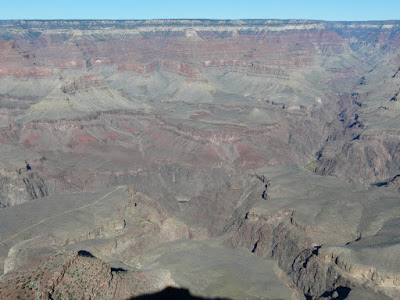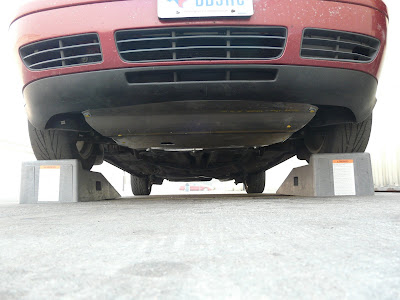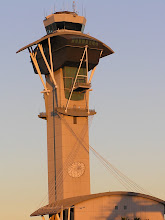A few days before Thanksgiving, I heard a piece on Public Radio International's program The World about the world's five busiest international airports. The rankings they used were based upon passenger count, as compiled by the Airports Council International. As it so happens, all five of these airports receive direct service from LAX:
Number 5: Hong Kong International Airport: Our primary carrier to and from Hong Kong is Cathay Pacific, who operates both passenger and cargo flights, using B747-400's. We've just started seeing B777-300's in passenger service on this route as well. Besides Cathay, we also have cargo service to Hong Kong with Singapore Cargo, who also uses B744's. Flight times seem to run between 14 and 15 hours.

A Cathay Pacific B747-400 lifts off runway 25 right, as a Delta B767-400 arrives at gate 58. This picture was taken last year, while the center taxiway was still under construction. Cathay's introduction of B773's is recent enough that I haven't managed to get a good picture of one yet; I've only seen them after dark.

I don't get many opportunities to photograph Cathay Pacific cargo aircraft either, as they also usually come and go at night. This particular aircraft was stranded here a while back with an engine problem, and I was able to shoot it as it was being towed away from the cargo ramp. Notice the partially engaged thrust reverser on the number three engine.

For whatever reason, Singapore Cargo, unlike Cathay, does operate here during daylight hours, and so is easier to catch with the camera. As you can see, this is another older shot, taken before the center taxiway was built.

A Lufthansa B744 touches down on runway 24 right. Judging from the glare and shadow, probably around one or two in the afternoon on a summer day. Lufthansa also brings in A346's, but those operate on the route to Munich.

An early morning shot, by the looks of it. A United B772 pushes off gate 77 onto taxiway Charlie. Meanwhile, a Skywest E120 Brasilia passes on taxiway Bravo, inbound to its gate at terminal 8, and a United B752 rolls out on runway 25 left. You can see the now-open center taxiway in this picture. When first opened, it was christened Alpha-Charlie, but has since been renamed Hotel.
Number 3: Amsterdam's Schiphol Airport: Served from LAX by KLM, whose daily flight uses a B744. Flight time is about nine and a half hours.

A KLM B744 arriving at gate 28. Most of the KLM aircraft carry just the KLM logo; this particular one is marked 'KLM asia'.

For comparison, here's an Air France B773 and a New Zealand B763. In the much-ballyhooed Air Force tanker contract competition, the B767 lost out to the Airbus A330. The B767 is smaller than the A330, which is smaller than the B777.

And here's a Tahiti Airbus just rotating off runway 25 right. The A330 and A340 were developed concurrently, and share many features. They're essentially the same airplane, with differing fuselage lengths and engine arrangements.

A trio of Londoners at terminal two. An Air New Zealand B744 at gate 21, an Air France B772 at gate 23, and a Virgin Atlantic A346 at gate 25. The jetway to nowhere between New Zealand and Air France is gate 21B, which is unusable when there's a heavy jet on gate 21.

For comparison, here's almost the same shot, except different:
Air New Zealand in a B772 at gate 21, and Air France with the stretched B773 at gate 23. Compare the backgrounds of these two photos: The lower one is the more recent, and shows the construction on taxiway Echo. This project was completed just before Thanksgiving. Besides replacing a lot of bad expansion joints, this project also included the relocation of taxiway Echo-8 to the east. In the first picture, the edge of E-8 is barely visible at the far left edge of the frame, behind the American Eagle SF34. In the lower picture, the new E-8 is the left of the two new concrete connectors to the runway; taxiway Victor is the one on the right, which leads to the beginning of the runway. Having E-8 in the new position allows us to use it for departure without the wake turbulence restrictions of an intersection departure.

Another early afternoon shot: Here, the New Zealand B772 is being towed away from the terminal to open up the gate for other flights. This aircraft will spend several hours parked on a maintenance ramp or remote hard stand before getting towed back to the terminal for the outbound flight later in the evening. Compare the B772 to the Japan Airlines B744 on taxiway Echo: even this, the shorter of the B777 models, is still a big aircraft. The Japan Air is on the way to runway 24 left for departure to Tokyo.


Two shots of American B772's: in the top shot, A Delta B764 lifts off runways 25 right. The lower shot shows a Continental B753 on taxiway Charlie. Both of these pictures date back to the center taxiway construction.

A United B772 in the old (pre-bankruptcy) paint scheme just rotating off runway 25 right while a Virgin America A320 taxis out on Bravo.

A British Airways (callsign: Speedbird) B744 towing into gate 121. Because of the tight alleys and concerns about jet blast, heavy jets get towed onto most gates instead of driving on. This process sometimes takes ten minutes, depending on the readiness of the tug and ground crew. Meanwhile, the aircraft is shut down, blocking the alley or taxiway. As you might imagine, this can be quite an inconvenience to the ground controller.
Note: View from the tower will be in hiatus for the next couple of weeks while I'm on the holiday road trip. Have a safe and happy holiday season!
 The visitor's initial view across the crater from the visitor center, which is at the north side. The southern wall of the crater, sheltered from the sun, has snow on the ground.
The visitor's initial view across the crater from the visitor center, which is at the north side. The southern wall of the crater, sheltered from the sun, has snow on the ground.
 These two pictures show the floor of the crater, where various efforts were made in the first decades of the 20th century to recover the meteorite.
These two pictures show the floor of the crater, where various efforts were made in the first decades of the 20th century to recover the meteorite. The visitor center and surrounding landscape, seen from the highest viewing platform.
The visitor center and surrounding landscape, seen from the highest viewing platform.


 This is the largest piece of the meteorite ever found.
This is the largest piece of the meteorite ever found.












































